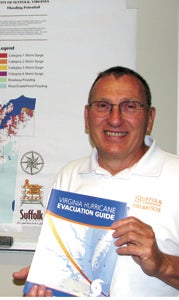Don’t let your guard down
Published 9:01 pm Monday, June 2, 2014
A below-average hurricane season is predicted, but that doesn’t mean folks should assume they don’t need to prepare for a hurricane.
The National Oceanic and Atmospheric Administration has predicted eight to 13 named storms, with three to six of them becoming hurricanes and one to two becoming major hurricanes.

Suffolk Fire and Rescue Capt. James T. Judkins shows off flood maps and holds the Virginia Hurricane Evacuation Guide, which is available at government buildings around the city.
AccuWeather.com, another source of predictions, has come down solidly within NOAA’s predictions, forecasting 10, five and two storms, respectively. An average season has 12, six and three, respectively. If this season is below average, it would be only the fourth below-normal season in 20 years.
As the city’s emergency management coordinator, Capt. James T. Judkins is used to dealing with hurricanes — or at least the threat of them.
Since Hurricane Hazel in 1954, Suffolk has managed to avoid sustained hurricane-force winds. Even memorable storms in the past 15 years — Floyd, Isabel, Irene — didn’t come close to the 130 miles per hour winds recorded in Hampton Roads during Hazel, though they did plenty of other damage.
“People look at Isabel as the storm of record,” Judkins said. “It was just a strong tropical storm.”
Isabel did more damage than it looked capable of on paper, though. Judkins said that was because of a number of factors — leaves were still on the trees, making them more prone to falling; another storm system with which Isabel interacted; and its sheer size.
Despite the relative quiet in the 11 years since Isabel and the somewhat quiet 2014 season predicted, though, Judkins still urges folks to be on guard.
“We can’t count ourselves in the clear, just because it’s projected to be or turns out to be a slow season,” he said.
He noted some of the most damaging storms in United States hurricane history — Alicia in 1983 and Andrew in 1992 — happened during seasons that were otherwise uneventful. Alicia, which devastated the Texas cities of Galveston and Houston, was one of only four named storms that year; Andrew, which struck Florida as a Category 5 monster, was one of only seven.
“We stress the point that we should not put our guard down,” Judkins said, urging folks to get their emergency kits together and have a plan for what they’ll do if a hurricane bears down on the area.
Folks should make their emergency kit, including at least a seven-day supply of food, water and medication for each family member and pet. Other tools and information sources, including a NOAA weather radio, also are recommended.
Judkins also encouraged people to find out now whether their home and their escape routes are prone to flooding.
“When the winds start blowing is not the time to start calling to find out if you live in a flood zone,” he said.
He also urged families with pets, families without reliable transportation or those who use durable medical equipment that requires electricity to make plans with extra details for how they will confront those obstacles.
“People will not leave home without their pets,” Judkins said. “We found that out during Katrina.”
Nansemond River High School currently is designated as the city’s pet-friendly shelter. King’s Fork High School has full generator power and is where folks who use medical equipment requiring electricity should plan to arrive before, not during, a storm.
“These are things you need to know,” Judkins said.
To get information on how your area floods or other information on disaster preparedness, visit www.suffolkva.us/em/preparedness or call 514-4536.






